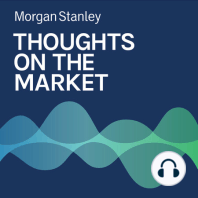3 min listen

Mike Wilson: Could Bond Market Consolidation Weigh on U.S. Equities?
Mike Wilson: Could Bond Market Consolidation Weigh on U.S. Equities?
ratings:
Length:
4 minutes
Released:
Dec 11, 2023
Format:
Podcast episode
Description
Here’s how upcoming inflation data and this week’s Federal Open Market Committee meeting could affect the U.S. bond and equity markets. ----- Transcript -----Welcome to Thoughts on the Market. I'm Mike Wilson, Chief Investment Officer and Chief U.S. Equity Strategist for Morgan Stanley. Along with my colleagues bringing you a variety of perspectives, I'll be talking about the latest trends in the financial marketplace. It's Monday, December 11th at 11am in New York. So let's get after it. Last week we discussed the increasing importance of interest rates in terms of dictating equity prices over the past six months. First, the sharp move higher in rates between July and October weighed heavily on stocks with the Russell 2000 selling up by 20% and the S&P 500 by 10%. Over the following six weeks, the opposite occurred as ten year yields fell by 90 basis points due to a perceived dovish pivot by the Fed and less longer dated bond issuance guidance from the Treasury. This move, lowering yields, helped the S&P 500 regain all of its losses from the prior three months, while several other indices, including the Russell 2000, clawed back 50% or more of their prior losses. This week, we remain focused on the bond market, which may be due for some consolidation after seeing such strong gains and that could weigh on equities in the near term. Friday's job data was important in this regard, with the stronger than expected release taking ten year U.S. Treasury yields higher by a modest 8 basis points. Though 135 basis points of Fed cuts that were priced into the bond market a week ago were now reduced to 110 basis points as of Friday's close. This reaction makes sense to us and there may be more to go in the near-term if inflation data released this week comes in a little hotter than consensus expects. Finally, the Fed is also meeting this week and will have taken notice of the data as well. With the unemployment rate falling by almost 2/10 in November, and inflation data potentially remaining bumpy over the next 3 to 6 months, the Fed may push back on the bond markets' more aggressive interest rate cuts. Given the severe underperformance of small caps this year, clients are more interested to know if the introduction of Fed rate cuts could reverse it. To address this question, we took a more in-depth look at small cap value and growth relative performance around prior Fed rate cuts. Interestingly, small cap value and growth underperformed large cap value and growth in the months before and after the Fed's first rate cut. Large cap growth is historically the best performing category following the first rate cut, and it also tends to see strong performance before the cut. We think these data reflect the notion that growth is typically slowing. When the Fed initially pivots to more accommodative policy. Given small caps greater sensitivity to economic activity, they tend to underperform in this context. Therefore, the more important determinant of small cap relative outperformance from here will be the rate of change on economic and earnings growth. Given our less optimistic growth outlook, we stick with a large cap defensive growth bias for one's portfolio. In addition to the recent fall in interest rates, the liquidity picture has also been a key driver of elevated equity valuations, in our view. More specifically, the draining of the reverse repo facility has continued to help fund the Treasuries elevated amount of issuance over the past six months. That issuance provided the financing for the fiscal deficit, which has been a key factor in stronger than expected GDP growth this year, especially in the third quarter. With over $800 billion remaining in a reverse repo facility, that balance should be drained towards zero next year and continue to play a supportive role both through Treasury funding and asset prices. Finally, our work suggests the Producer Price Index is a very good leading indicator for sales growth. Recent softness in the
Released:
Dec 11, 2023
Format:
Podcast episode
Titles in the series (100)
Mike Wilson: How Confident Are U.S. Businesses in the Economy? by Thoughts on the Market